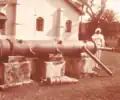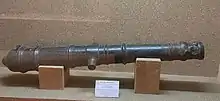
Ahom artillery included many gunpowder-related armaments and was a very important dimension of the Ahom military technology. It is believed that fire-arms were first introduced at the time of Afghan invader Turbak Khan's invasion in 1532, but reference related to firearms is found much prior to that date, in 1523, Ahoms received 69 fire-arms after defeating the Chutiyas.[1] More sources mention firearms being employed in the service of Ahoms, before the Mughal origins.[2] Jean-Baptiste Tavernier even believed in that "it was from Assam that the use of gunpowder had entered the kingdom of China."[3]
An Mughal account states in 1662:
"They cast excellent matchlocks and bachadar artillery and show great skill in this craft. They make first-rate gunpowder..."
Ram Singh, who led the invasions of Assam in the 1660s-70s, commented:
Every Assamese soldier is expert in rowing boats, inshooting arrows, in digging trenches and in wielding guns and cannons. I have not seen such specimens of versatility in any other part of India
The Ahoms excelled in making various kinds of guns, matchlocks, artillery, and cannons. They also possessed a large number of them at their disposal and also had an elite regiment of musketeer princes (Hiloidari Konwars). The materials for making gunpowder were locally sourced and developed an indigenous method for producing it. For the manufacture of firearms, a department was created under the supervision of an officer called Kharghariya Baura.[6][7]
There were various types of cannons and guns, five types of cannons, and eleven types of guns.[8]
Gallery
 Big Ahom cannon near the dist.court, Sivasagar, 1902.
Big Ahom cannon near the dist.court, Sivasagar, 1902..jpg.webp) Bell metal musket of Ahom era.
Bell metal musket of Ahom era..jpg.webp) Ahom musket with inscription.
Ahom musket with inscription..jpg.webp) Haat noliya hiloi.
Haat noliya hiloi. Hatimuriya bortup.
Hatimuriya bortup. Artillery battery of Gadadhar Singha with lion like shaped muzzle.
Artillery battery of Gadadhar Singha with lion like shaped muzzle. Cannon with inscription.
Cannon with inscription.
See also
Notes
- ↑ "...the Ahoms got 69 fire-arms from the Chutiyas whom they defeated in 1523." (Baruah 1986:397)
- ↑ (Sun 2000:45)
- ↑ (Kakoty 2003:172)
- ↑ (Sun 2000:45–46)
- ↑ (Sun 2000:45–46)
- ↑ (Kakoty 2003:173–178)
- ↑ (Baruah 1986:397)
- ↑ (Kakoty 2003:175)
References
- Baruah, S L (1986), A Comprehensive History of Assam, Munshiram Manoharlal
- Kakoty, Sanjeeb (2003), Technological changes and mode of production in the evolution of the Ahom state, Regency Publications, pp. 172–178
- Sun, Laichen (2000), Ming-Southeast Asian Overland Interactions, 1368-1644, University of Michigan